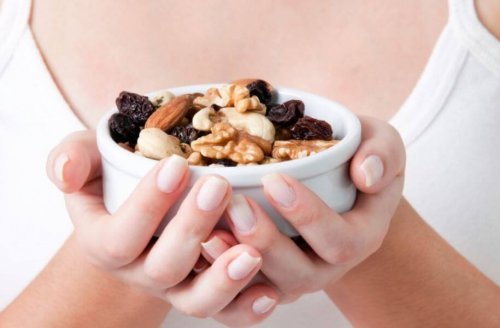Selenium: an Antioxidant that Prevents Cell Degeneration

As with potassium, sodium, iron, and others, selenium is a mineral that’s necessary for the proper functioning of your body. Specifically, it’s an antioxidant micromineral that we acquire through food and the body’s own reserves, located in the liver.
In recent times, selenium has gained relevance from its interaction with vitamin E. When diets aren’t balanced, a low presence of this mineral in a medium with a high presence of vitamin E could be linked to various diseases; such as prostate cancer, among others.
Although there’s no conclusive evidence in this regard, there are indications suggesting that the absence or shortage of selenium in the body has significant risks. This includes infertility in men, arthritis and joint inflammations, and heart problems, such as Keshan’s disease.
What functions does selenium fulfill in our body?
As we’ve mentioned, its main quality is that of being an antioxidant. This implies that it delays cell aging. By regenerating and protecting cells, antioxidants prevent the body from diseases such as cancer.
Nevertheless, everything that we incorporate into our body in a supplementary way must be controlled by a specialist. Lots of people, in their eagerness to immunize themselves against cell damage, choose mineral supplements with the presence of selenium without knowing exactly what it is or how it works.
In fact, with a balanced diet, selenium reserves are compensated without outside help. It’s a fundamental element, which we need to incorporate into proteins to form selenoproteins. If we do that, this micromineral will integrate the antioxidant enzymes that fight free radicals.
Basically, the function of selenium is to regulate the endocrine system, with greater preponderance in the thyroid gland. It also activates the immune system constantly, which promotes the production of white blood cells. In regard to the thyroid, selenium is responsible for its healthy growth and development.

These are the main roles of selenium; although, there are at least 25 other tasks in which selenoproteins come into play as antioxidants. Some of them are:
- Neutralizing the harmfulness of heavy metals, such as cadmium, arsenic, mercury, and lead.
- Aiding the metabolism of fats and lipids.
- Promoting the healthy growth of nails and hair.
- They influence male fertility.
What should your diet include?
It’s not necessary to take selenium supplements if you want to increase the number of antioxidants in your body. The reserve of this element that comes from food is called selenomethionine. Meanwhile, the one that comes from the liver and is present as a liver enzyme is glutathione peroxidase.
The presence of selenium in food will depend on the amount of this micromineral present in the soil from which it’s extracted; either the soil in which the animals graze or that of the vegetables. However, products of plant origin have higher amounts.
We recommend adults to ingest between 50 and 60 micrograms (mcg) of selenium per day. The foods in which there’s more presence of this mineral are cereals, meat and fish, nuts, and shellfish. These amounts vary in children and the elderly.
To get an idea, a serving of 30 grams of Brazil nuts contains 544 mcg of this element; 85 grams of beef have 35 mcg; a cup of whole wheat flour has 74 mcg and a slice of white bread contains 4 mcg.

The stage in life that demands the highest amount of selenium is between the ages of four and eight years. The tables that provide information about the proportions and foods in a balanced diet can be fundamental to have control over this mineral’s influence.
Globally, it’s in countries such as China where, due to the type of soil, there are usually low amounts of selenium in food. Hence, the propensity for heart disease is greater, as well as a weak immune system or hypothyroidism.
In conclusion, selenium as an antioxidant is acquired naturally through a varied diet. Selenium supplements are only necessary in case you suffer from chronic diseases; mainly those related to absorption problems. Nonetheless, if you’re in doubt, it’s best to seek expert advice.
As with potassium, sodium, iron, and others, selenium is a mineral that’s necessary for the proper functioning of your body. Specifically, it’s an antioxidant micromineral that we acquire through food and the body’s own reserves, located in the liver.
In recent times, selenium has gained relevance from its interaction with vitamin E. When diets aren’t balanced, a low presence of this mineral in a medium with a high presence of vitamin E could be linked to various diseases; such as prostate cancer, among others.
Although there’s no conclusive evidence in this regard, there are indications suggesting that the absence or shortage of selenium in the body has significant risks. This includes infertility in men, arthritis and joint inflammations, and heart problems, such as Keshan’s disease.
What functions does selenium fulfill in our body?
As we’ve mentioned, its main quality is that of being an antioxidant. This implies that it delays cell aging. By regenerating and protecting cells, antioxidants prevent the body from diseases such as cancer.
Nevertheless, everything that we incorporate into our body in a supplementary way must be controlled by a specialist. Lots of people, in their eagerness to immunize themselves against cell damage, choose mineral supplements with the presence of selenium without knowing exactly what it is or how it works.
In fact, with a balanced diet, selenium reserves are compensated without outside help. It’s a fundamental element, which we need to incorporate into proteins to form selenoproteins. If we do that, this micromineral will integrate the antioxidant enzymes that fight free radicals.
Basically, the function of selenium is to regulate the endocrine system, with greater preponderance in the thyroid gland. It also activates the immune system constantly, which promotes the production of white blood cells. In regard to the thyroid, selenium is responsible for its healthy growth and development.

These are the main roles of selenium; although, there are at least 25 other tasks in which selenoproteins come into play as antioxidants. Some of them are:
- Neutralizing the harmfulness of heavy metals, such as cadmium, arsenic, mercury, and lead.
- Aiding the metabolism of fats and lipids.
- Promoting the healthy growth of nails and hair.
- They influence male fertility.
What should your diet include?
It’s not necessary to take selenium supplements if you want to increase the number of antioxidants in your body. The reserve of this element that comes from food is called selenomethionine. Meanwhile, the one that comes from the liver and is present as a liver enzyme is glutathione peroxidase.
The presence of selenium in food will depend on the amount of this micromineral present in the soil from which it’s extracted; either the soil in which the animals graze or that of the vegetables. However, products of plant origin have higher amounts.
We recommend adults to ingest between 50 and 60 micrograms (mcg) of selenium per day. The foods in which there’s more presence of this mineral are cereals, meat and fish, nuts, and shellfish. These amounts vary in children and the elderly.
To get an idea, a serving of 30 grams of Brazil nuts contains 544 mcg of this element; 85 grams of beef have 35 mcg; a cup of whole wheat flour has 74 mcg and a slice of white bread contains 4 mcg.

The stage in life that demands the highest amount of selenium is between the ages of four and eight years. The tables that provide information about the proportions and foods in a balanced diet can be fundamental to have control over this mineral’s influence.
Globally, it’s in countries such as China where, due to the type of soil, there are usually low amounts of selenium in food. Hence, the propensity for heart disease is greater, as well as a weak immune system or hypothyroidism.
In conclusion, selenium as an antioxidant is acquired naturally through a varied diet. Selenium supplements are only necessary in case you suffer from chronic diseases; mainly those related to absorption problems. Nonetheless, if you’re in doubt, it’s best to seek expert advice.
All cited sources were thoroughly reviewed by our team to ensure their quality, reliability, currency, and validity. The bibliography of this article was considered reliable and of academic or scientific accuracy.
- National Institutes of Health. Datos sobre el selenio. Extraído de: https://ods.od.nih.gov/pdf/factsheets/Selenium-DatosEnEspanol.pdf
- Institutos Nacionales de la Salud / Biblioteca Nacional de Medicina de los EE. UU. El selenio en la dieta. Extraído de: http://e-lactancia.org/media/papers/Selenio_en_la_dieta_MedlinePlus2017.pdf
This text is provided for informational purposes only and does not replace consultation with a professional. If in doubt, consult your specialist.








